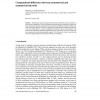Free Online Productivity Tools
i2Speak
i2Symbol
i2OCR
iTex2Img
iWeb2Print
iWeb2Shot
i2Type
iPdf2Split
iPdf2Merge
i2Bopomofo
i2Arabic
i2Style
i2Image
i2PDF
iLatex2Rtf
Sci2ools
NIPS
1998
1998
Computational Differences between Asymmetrical and Symmetrical Networks
Symmetrically connected recurrent networks have recently been used as models of a host of neural computations. However, biological neural networks have asymmetrical connections, at the very least because of the separation between excitatory and inhibitory neurons in the brain. We study characteristic differences between asymmetrical networks and their symmetrical counterparts in cases for which they act as selective amplifiers for particular classes of input patterns. We show that the dramatically different dynamical behaviours to which they have access, often make the asymmetrical networks computationally superior. We illustrate our results in networks that selectively amplify oriented bars and smooth contours in visual inputs.
| Added | 01 Nov 2010 |
| Updated | 01 Nov 2010 |
| Type | Conference |
| Year | 1998 |
| Where | NIPS |
| Authors | Zhaoping Li, Peter Dayan |
Comments (0)

